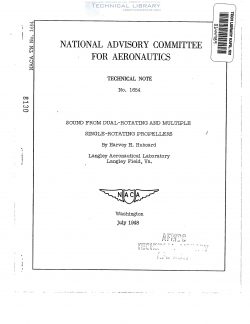naca-tn-1654
- Version
- 149 Downloads
- 1.23 MB File Size
- 1 File Count
- December 4, 2016 Create Date
- December 4, 2016 Last Updated
National Advisory Committee for Aeronautics, Technical Notes - Sound from Dual Rotating and Multiple Single Rotating Propellers

Sound measurements for static conditions in the tip Mach number
range 0.37 to 0.89 are presented for three different dualarotating—
propeller configurations and one combination of two single—rotating
propellers operating side by side in the same plane of rotation.
The results obtained are compared with a theoretical analysis of the
problem and excellent agreement is found.
The sound from a four—blade dualérotating propeller was found to
fluctuate approximately between that of a two—blade and a fouréblade
single—rotating propeller when the propellers are absorbing the same
power at the same tip speeds; the amount of fluctuation was found to
depend on the angle of overlap with respect to the observer. By
correct phasing of the components of a dualerotating prOpeller in
flight, the sound reaching the ground in a given direction can be
reduced by a small amount.
Mutual interference has been detected in the form of sound near the
axis of rotation for dual—rotating propellers. The magnitude of the
sound resulting from this interference has been found to vary directly
as the power and as the cube of the tip speed.
The problem of propeller noise of large airplanes necessitates an
understanding of the way in which the noise fields from multiple
propellers add up. Since very few sound measurements have been reported
on dual—rotating propellers and multiple single—rotating propellers,
extension of the theory for predicting the sound and an experimental
check of this theory seemed desirable.
A solution for the noise from a single—rotating propeller in which
the air forces are steady has been given.by Gutin in reference 1. For
dual—rotating propellers, the mutual interference between them.results
in a periodic variation of air loads on the blades. An exact solution
of the problem taking this fact into account is difficult, particularly
since the load variation has not been accurately determined.
Static tests were made for a series of dualerotating propellers
and one combination of two single—rotating propellers operating side
by side in the same plane. Data obtained were compared with an °
elementary theoretical analysis expressing the noise from a dual—
rotating propeller as the sum of the noise from each of two single—
rotating propellers and neglecting mutual interference.
| File | Action |
|---|---|
| naca-tn-1654 Sound from Dual Rotating and Multiple Single Rotating Propellers.pdf | Download |

Comment On This Post